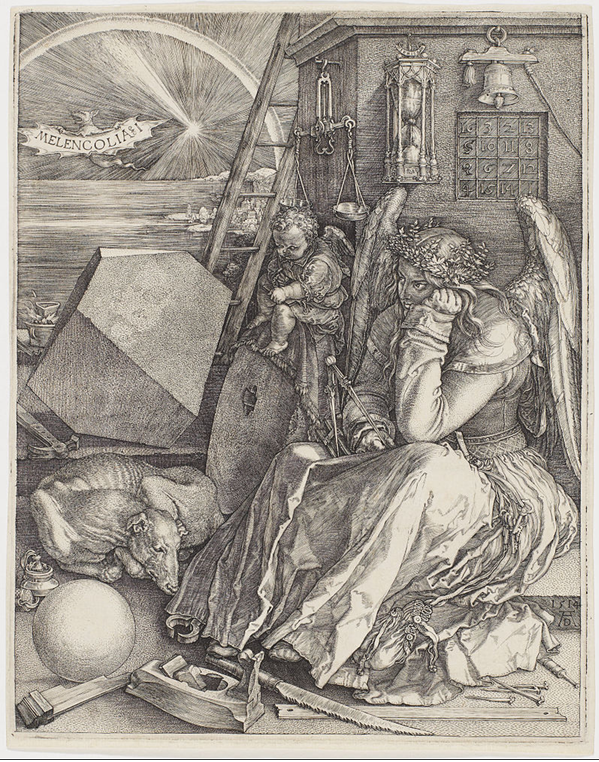 The fourth of Galen’s four fluid humours of the body, μέλαινα χολή, black bile, was associated, when in supposed excess, with a melancholic temperament, as defined in the OED: “Originally … sullen, unsociable, given to causeless anger, brooding (obs.). Later: liable to melancholy; depressed, gloomy, mournful”.
The fourth of Galen’s four fluid humours of the body, μέλαινα χολή, black bile, was associated, when in supposed excess, with a melancholic temperament, as defined in the OED: “Originally … sullen, unsociable, given to causeless anger, brooding (obs.). Later: liable to melancholy; depressed, gloomy, mournful”.
The IndoEuropean root MEL described any dark colour, typically black. The Greek adjectival derivative μέλας, μέλαινα, μέλαν (masculine, feminine, neuter) has given us melanin, the dark pigment in skin and hair, and derivatives such as melanism, melanocyte, melanoma, and melanuria, as well as melaena and of course melancholy. Psilomelane is an oxide of manganese that occurs in smooth, black, grape-like accumulations (Greek ψῑλός, bare). Melaleuca is an Australian genus of trees and shrubs with black trunks and white branches (Greek λευκός, white). Melampyre is purple cow-wheat (Greek πυρός wheat), a plant with black seeds that grows in cornfields. Melampodium (literally black foot) is black hellebore; borage and hellebore, Robert Burton claimed, in The Anatomy of Melancholy, were
Soveraigne plants to purge the veines,
Of melancholy, and cheare the heart,
Of those blacke fumes which make it smart.
To cleare the Braine of misty fogges,
Which dull our senses and Soule clogges.
The best medicines that ere God made
For this malady, if well essaid.
But Pliny recommended hellebore for ascites, and it does contain cardiac glycosides.
When the German philosopher Philipp Schwartzerd (1497–1560) wanted to render his surname in Greek he translated it directly—Melanchthon (χθών, earth). Melanesia is a group of islands in the south-west Pacific, “inhabited by dark-skinned peoples”, as the OED puts it; it first appeared in French, in JSC Dumont D’Urville’s Voyage de l’Astrolabe (1832).
In Latin any dark river might be called Melas; mulleus was a reddish-purple shoe worn by patricians, a sort of mule; and mullus was a red mullet. In German Maler is a painter and in English a maulstick (Dutch maalstock) is a paintbrush.
One would expect girls called Melanie to have black hair, but a search for pictures of Melanies suggests that many of them—including Melania Trump, Mel Giedroyc, and ex-Spice Girl Mel C—do not. Mel B is an exception. But then, I haven’t taken dyes into account.
The word melancholy entered English at the end of the 14th century, and was mentioned several times by Chaucer. Later texts devoted to the subject included A Treatise on Melancholy by Timothy Bright (1586) and The Anatomy of Melancholy by Robert Burton (1621). Burton, having classical humoral theory in mind and describing melancholy as cold and dry, wrote that “the common sort define it to bee a kinde of dotage without a feaver, having for his ordinary companions, feare, and sadnesse, without any apparant occasion.”
Perhaps the most famous depiction of melancholy is Albrecht Dürer’s 1514 engraving, Melencolia I (picture). We know that it’s by Dürer, because he signed it with his monograph (in the bottom right hand corner). We also know the date of the engraving, because he included a magic square (in the top right hand corner), in which the numbers one to 16 are used and the date of the engraving, 1514, appears in the two middle cells in the bottom line. In this square the numbers in each row and column sum to 34, as do the numbers in the diagonals, the four corners, and each of the four outer quadrants and the central one. The engraving is rich with imagery. Note, for example, the seascape with rainbow and comet and the several scientific symbols—an hourglass, scales, compasses, and the large truncated polyhedron with its faint imprint of what may be a skull. One could not become melancholy studying Dürer’s engraving.

Jeffrey Aronson is a clinical pharmacologist, working in the Centre for Evidence Based Medicine in Oxford’s Nuffield Department of Primary Care Health Sciences. He is also president emeritus of the British Pharmacological Society.
Competing interests: None declared.